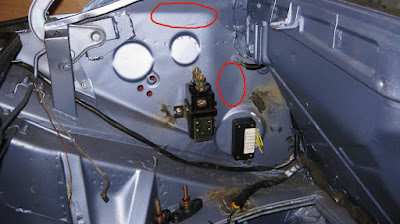June 17, 2010 - I've finally made the mental decision to go with LiFePO4 (lithium iron phosphate) batteries instead of lead acid. The decision was a long and difficult one but after carefully weighing the facts, it was obvious that lithium was the intelligent way to go.
The cost of 20 US Battery US-2200 232AH batteries is approx $2600, would weigh 1240 lbs, provide 120V traction pack, may last 3-5 years, and would probably only get a range of perhaps 40-50 miles on a single charge with moderate driving.
The cost of 40 Thundersky TS-LFP200AHA batteries is approx $10000, would weigh 640 lbs, provide a 128V traction pack, may last 8-13 years, and would probably get a range of 80-100 miles on a single charge with moderate driving. Thundersky specs >= 3000 charge cycles for 80% DOD and >= 5000 charge cycles for 70% DOD.
What's amazing about the lithium batteries is that they have an energy density of almost 5 times that of lead acid batteries. That means that a lithium battery stores 5 times the power per kilogram of weight than lead acid and 2 times as much as NiMH.
There are two different form factor 200AH batteries from Thundersky. 4 cells will constitute a 12.8 battery pack with 10 batteries supplying 128V. The Type A packs will fit into the polypropylene battery boxes quite nicely. 5 packs will fit into the front box and 5 will also fit into the engine box both boxes will have room to spare. The Type B packs are a good bit larger than the Type A but will fit into the racks for the front and engine compartments.
Thundersky TS-LFP200AHA Type A is 11in H x 7-1/4in W x 2-3/4in L

Thundersky TS-LFP200AHA Type B is much larger at 10" H x 14-1/4" W x 2-1/4" L

Considering the overall cost of the restoration and conversion, even though the lithium batteries are 4 times the cost of lead acid batteries, the lithium batteries will provide the conversion with a quality traction pack that will make it comparable in range to that of the new Nissan Leaf. The lithium pack will also allow me the opportunity to drive a round-trip work commute without having to charge at work. The addtional power will allow me to install an air-conditioning system that is much needed here in FL.
To ensure that extra precaution is taken to protect my significant investment in lithium technology, I have decided to purchase an EVision system from Metric Mind. The main purpose of the EVision is to monitor the State of Charge and ensure that I don't exceed an 80% DOD.
Here's the EVision displayed in both color schemes. I like the blue and white display.

The EVision should barely fit into the Porsche's fuel gauge housing. The housing is about 95mm in diameter whereas the Evision is about 73mm in diameter and PC board is 86mm wide. Here's the fuel gauge:

And the EVision In-dash display:

I'm still trying to find out what the cost of the EVision is. The Metric Mind website currently says price is TBD but I seem to remember looking at the site about a year ago and thought it said $600-700 plus you need $100 worth of shunts, so, I'm going to budget about $1000.
Finally got a response from Victor Tikhonov of Metric Mind but he replied saying that pricing was still not available but that it shouldn't be more than $900. So my budget estimate was right on the mark.






















































